 Thirteenth-century hero William Wallace is known worldwide for his legendary military maneuvers in the fight for Scottish independence. Filtered through legends and the popular film Braveheart, Wallace’s true story remains a mystery to many. Let’s explore some things you may not know about William Wallace:
Thirteenth-century hero William Wallace is known worldwide for his legendary military maneuvers in the fight for Scottish independence. Filtered through legends and the popular film Braveheart, Wallace’s true story remains a mystery to many. Let’s explore some things you may not know about William Wallace:
1. Wallace was a man of faith. He grew up in a prominent Christian family, and he learned early to develop strong convictions toward prayer and the importance of seeking God’s will. Prior to submitting to the call to the battle, Wallace desired sincerely to become a Benedictine monk. Having been educated by his uncles who were Augustinian priests, Wallace likely held a great deal of biblical knowledge. As a boy he was given a Psalter – and when tried for treason, he asked that that very Psalter be held in front of his face until he died.
2. Wallace did not wear face paint. In the film Braveheart, Wallace dons blue face paint before battle. In reality, the practice of dying the skin blue was a pagan ritual more common among spiritualistic societies like the Picts and early Celts. Scotland, being a predominantly Christian nation in Wallace’s day, was beyond this type of practice.
3. Wallace did not wear a kilt. Tartan, often worn as a kilt and cape by Celtic nations such as Scotland, did not reach popularity until about the 16th century. Although there are records of tartans predating this era, they were earth-toned and basic, far from the elaborate color patterns we associate with Scottish clans today. Surprisingly, Scotland’s greatest warrior, guardian and diplomat never wore a kilt.
4. Wallace had an advanced education. He began reading at a very young age. He spoke at least four languages fluently, and possibly more, having Gaelic as his native tongue and learning Latin, French, German and possibly English from his religious education. He was an accomplished political mind, able to strategize tactically, and served overseas in France and throughout Europe as a diplomat for Scotland. He possessed strong leadership capabilities, motivating the Scottish people to place their trust in him. Raising up an army of rugged countrymen to fight against the English, his organizational and training capacities must have been astounding, especially considering the fact that he led an army that was much smaller than the English.
Wallace was a man motivated by freedom. Sir James Fergusson quoted Wallace to have said, “My son, freedom is best, I tell thee truth, of all things to be won. Then never live within the bond of slavery.” Wallace desired people to treasure and protect liberty with their own lives, seeing it as the only certainty for the continuance of the church, the family and the nation. His heroic martyrdom for freedom’s sake demonstrates the intensity of his passion for freedom.
Much of the freedom we enjoy today is the result of a paradigm produced by Wallace’s faith and courage 500 years ago. The world desperately needs heroes willing to take a stand for freedom. The world needs a new generation of Wallaces.
References
“William Wallace.” Wikiquote, Wikipedia, 9/11/2014. Wikipedia. Web. 11/6/2014. Sir William Wallace-True Patriot. www.wjpbr.com/wallace. N.p.. N.d. Web. 10/6/2014
Two William Wallace letters return to Scotland, thehistoryblog.com/archives/14475. The History Blog, 1/12/2012. Web. 11/6/2014.
“Tartan.” en.wikipedia.org/wiki/tartan. Wikipedia. 11/3/2014. Web. 11/6/2014
“Celtic Warfare.” en.wikipedia.org/wiki/Celtic_warfare. Wikipedia, 10/20/2014. Web. 11/6/2014.


3 Comments
Amazing educational accomplishments for the 13th century. Here in modern day America, we experiment with ebonics and common core. After all, a dumbed down population is much easier to lie to and control.
Thank you.
Thank you for the clarifications that point 2-4 bring to this much misunderstood historical figure. All three of those points are factual.
I’d just like to point out that #1 us not factual in the way that the other three points are. We know #2 and #3 are factual because we know when blue word went out of use in Scotland and when tartan kilts came into use. We know #4 is the case because we have actual historical documents showing that Wallace had that kind of knowledge.
We have nothing of that kind for point #1. Of course, every European of his time would have self-identified as Christian (which was practically synonymous with “human being”), but all the statements we have about his personal faith don’t come from real documentary evidence, but rather later, highly fictionalized and romanticized accounts of his life, the main one being Blind Hary’s_Wallace_–a work that bears more resemblance to what we now call “historical fiction” than it does to what we call history. Most of it is a mixture of medieval romance, folk legend, and pure fantasy. We really don’t have any historical evidence about Wallace’ personal faith one way or the other (in fact, we know very little about the historical person at all).
That doesn’t mean there’s a problem with presenting him as a person of strong faith in a fictionalized narrative, of course, but it should be understood that that part of the character is a product of the “fiction” component of historical fiction, not the “history” part.
Add Comment